Gay Liberation Front: Looking back at the revolutionary LGBTQ group 50 years on
In its short life, the GLF set up the Gay Switchboard, the first gay newspaper and, crucially, laid the foundations for future gay rights movements that followed. Here, Attitude talks to two early members.
By Will Stroude
This article first appeared in Attitude issue 324, Summer 2020
Words: Cliff Joannou with Dan Glass
Fifty years ago, a group of people gathered to lay the foundations for a movement that would change the British LGBTQ community and society’s attitude towards it for ever. The Stonewall uprising in New York on 27 June 1969 a year prior had sent ripples across the Atlantic, emboldening a growing number of activists who, five decades later, continue the battle for queer liberation.
Times were starkly different for LGBTQ people in 1970. ‘Gay’ was a relatively new term that encompassed both men and women. People that weren’t heterosexual were more commonly referred to as homosexuals by the media and in society – we were a peculiar scientific aberration. Trans, non-binary, and intersex identities were decades away from being recognised. We were all queers, in the pejorative sense. Although the word has today been reclaimed in a celebration of non-compliance to expected ways of being, thinking or loving, back then queers were considered perverts and sexual deviants.
The Gay Liberation Front originated in the US shortly after the Stonewall riots, but its London branch would be formed in October 1970 after Bob Mellors and Aubrey Walter met at a demo outside the Women’s House of Correction in New York. Inspired by meetings with the Black Panthers, they saw beauty in queerness, and sought to take ownership of the term, reshape it, and offer society a different vision of the future. A charter document of eight demands or principles for gay liberation was drafted. The Seventies dawned, glistening with hope and a new idea of love.
The GLF was audacious because its members were uncompromisingly determined not to be undermined, despite the difficulties standing up and speaking out might bring. Its strength was not in numbers, but in the unity and power of the many different individuals that came together to share pride in their identity.
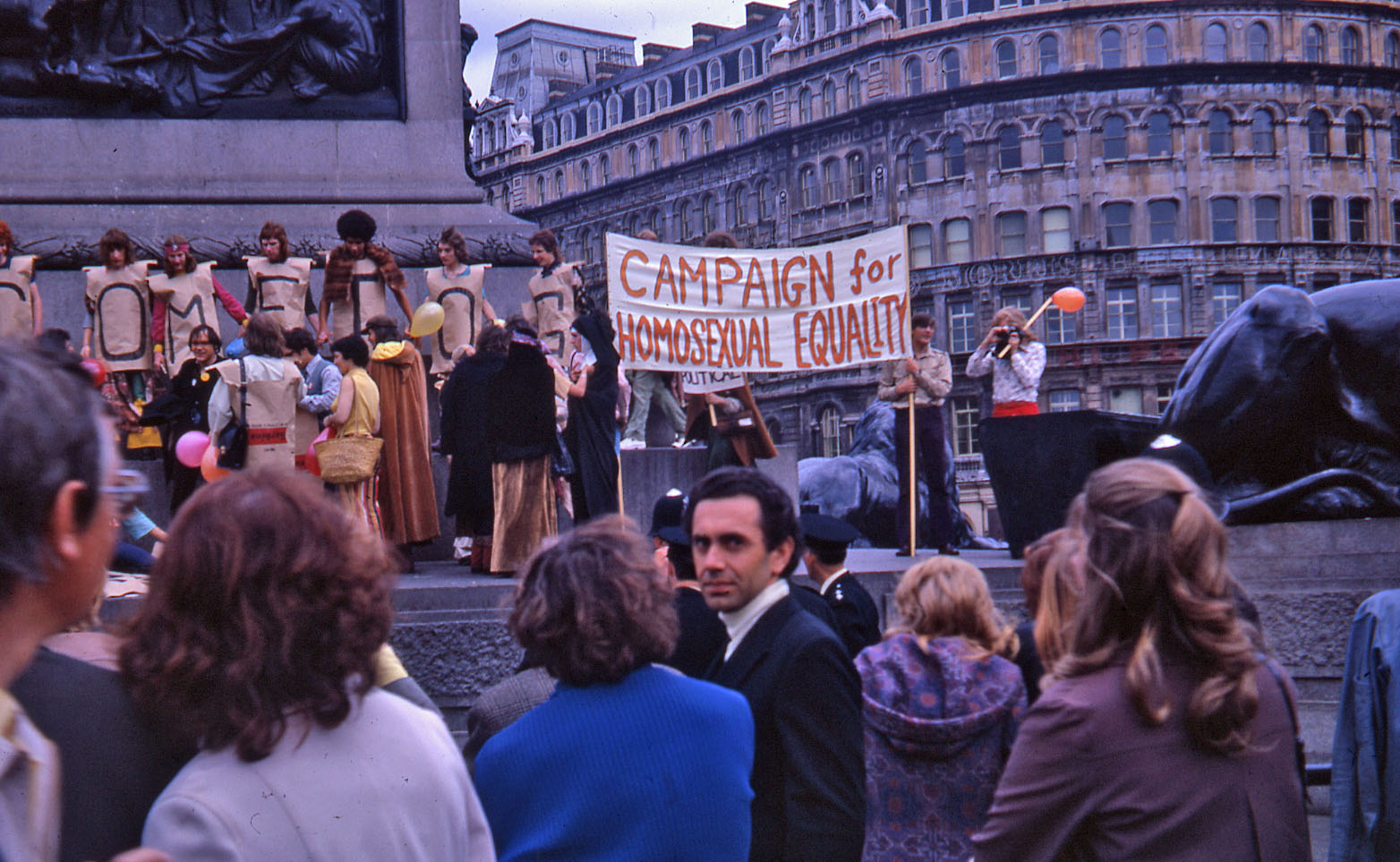
Gay Liberation Front protest in London’s Leicester Square, August 1972 (Image: LGBTQ+ Archives, Bishopsgate Institute)
“When we started, I was doing GLF all the time,” says Nettie Pollard, who attended her first GLF meeting in April 1971. She threw herself into the group’s activities. “On Monday, I’d go to the Action Group; on Tuesday, I’d go to the Red Lesbian Brigade; on Wednesday, I’d go to the general meeting; on Thursday, I’d go to Camden GLF; on Friday, I’d go to the Women’s Group. Saturday, we’d have a demonstration, and Sunday I’d go to the Counter-Psychiatry group.”
Nettie grew up in north London and found her way into GLF through what most might consider unconventional means even by today’s standards. “My father read about GLF in a newspaper and read it out to me and my best friend Jake Wynter, who was staying [with us].
“It was the most amazing experience. Suddenly, a new world opened up as we walked through the door at Middle Earth [club] in Covent Garden. Here were around a hundred people – men, women, trans, old and young – who wanted to change the world. It was like being suddenly released from prison. What they were discussing was oppression and non-monogamy and working for a liberated world for everyone.”
Nettie has continued to carry the GLF’s message forward, even though the group disbanded in 1973. The GLF opened her eyes to her identity when she was introduced to the women who were sitting together and learned about the Women’s Group. Interestingly, Nettie hadn’t quite ‘identified’ her sexuality by that point.
“I knew that I was different as a small child. I hated the condescending way little girls were regarded. I couldn’t see myself in a conventional marriage,” she says, although she underscores this by adding how she never felt uncomfortable with her sexuality, only with sexist roles imposed on women.
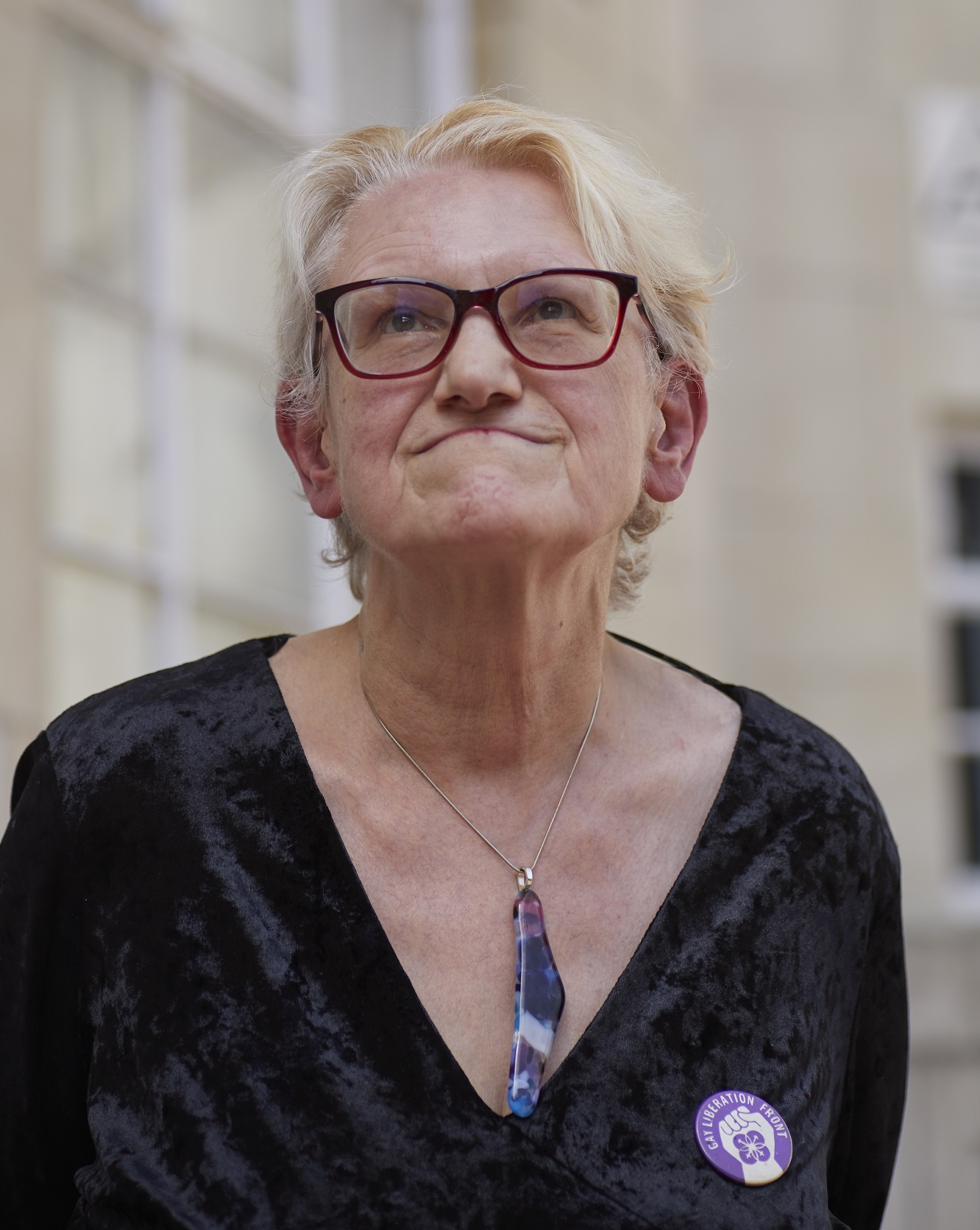
Former Gay Liberation Front member Nettie Pollard continues to campaign 50 years on (Photography: Francisco Gomez de Villaboa)
“At that time, I wasn’t aware of attraction to women. That night, Jake told me he was gay and had been suicidal. I swore l’d do everything in my power to fight gay oppression. We went to GLF again the next week, and Jake met Derek Jarman, who became his first boyfriend. I continued with GLF, and by December I suddenly found that I was attracted to women after all,” she smiles. “Whoop, whoop! And I never looked back!”
Ted Brown was born in the US in 1950 to Jamaican parents, and moved to London nine years later. His life changed for ever in the summer of 1969 when he opened a newspaper. “I excitedly read a flippant article reporting on the Stonewall riots, where lesbians and gays were physically fighting off police brutality. But I had no way of contacting those rebels.”
A year later, a visit to the cinema to see The Boys in The Band, Hollywood’s first ever film to feature gay men as lead characters, would change all that. “I went alone to the Odeon, Leicester Square. Though the film raised some worthwhile issues and countered a few stereotypes, its overall portrayal of gay men as pathetic, aimless self-haters was a real downer,” he says.
He may have felt dejected, but that evening turned out to be a moment that would change his life for ever when he met some people leafleting against the movie. They turned out to be members of the newly formed London Gay Liberation Front. About a week later, he attended his first GLF meeting at the London School of Economics.
“With about 60 people assembled in the hall, it was the first time I’d ever met a large group of LGBT people,” Ted says. “Furthermore, they were speaking passionately about the abuse they’d suffered, expressing their determination to take no more, while presenting their perspectives on love and life. It was astonishing and inspiring, especially as the few previous contacts I’d had with gay men had involved a necessarily furtive way of behaving, mixed with little pride.”
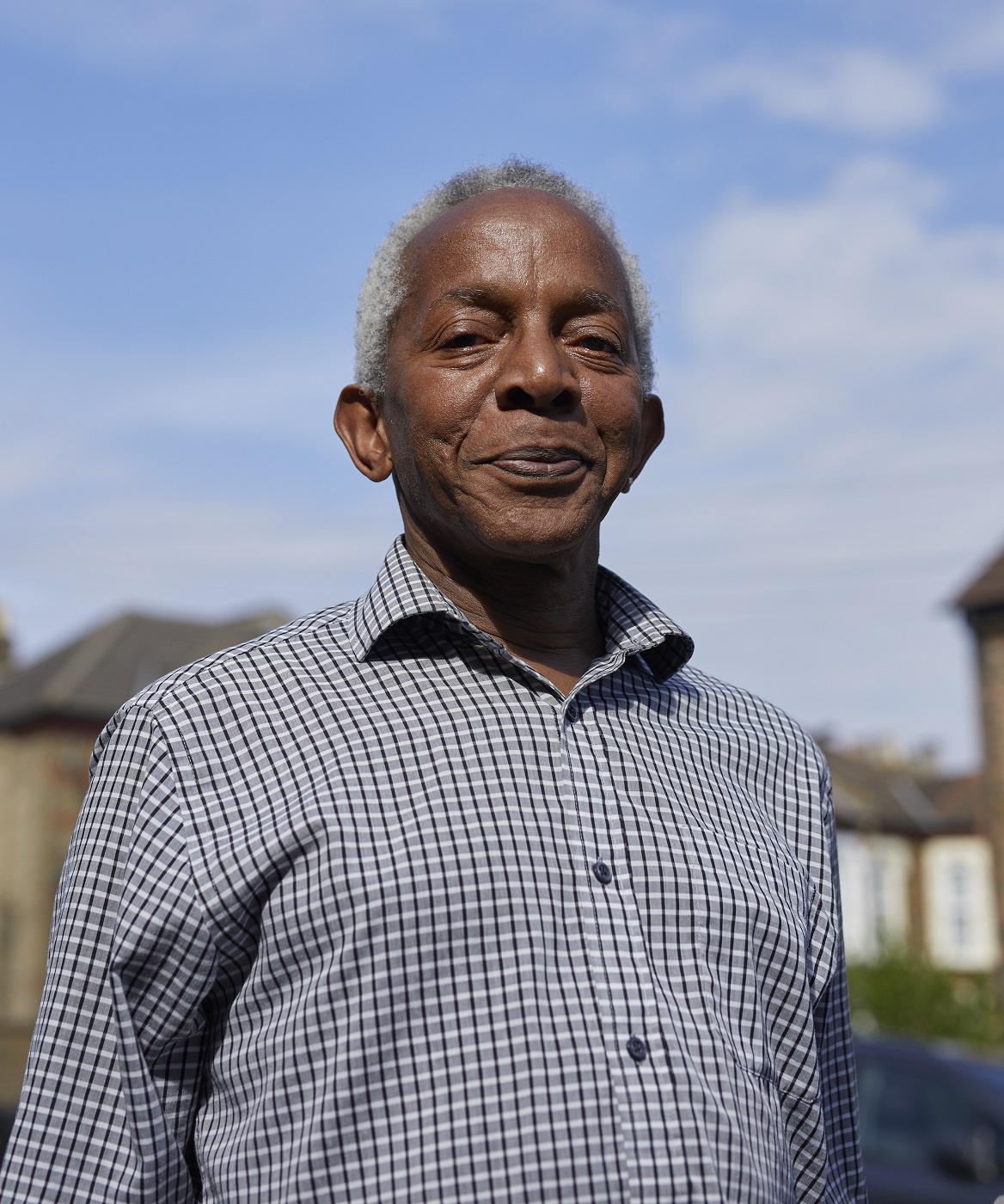
Ted Brown joined the Gay Liberation Front to fight racism and homophobia in ’70s Britain (Photography: Francisco Gomez de Villaboa)
Away from the shadows of shame, here was a group of people that found joy in their identity. “I was thrilled to be among people who were proud and open about who they were, who were ‘out’ and fired up to encourage others to be so, too. I was more angry than afraid about how we might and had been treated.”
It was perhaps inevitable that Ted would find himself at the heart of the UK’s first queer rights movement. During the 1950s and 1960s, his parents campaigned in the National Association for the Advancement of Coloured People (NAACP) led by Martin Luther King, where they would also hear speeches from one of its other leaders, the openly gay Bayard Rustin.
“The GLF looked to my family’s experiences and those of the women’s movements and the black activists Civil Rights movement in the US for inspiration to press for change,” he says, adding that these organisations that today may be presented as disparate once had a lot more in common.
Although the ideals of freedom from oppression were the same, their tactics were somewhat different. Nettie says the GLF’s greatest achievement was to mix very serious politics with play. “Men and women dressing up as Miss World contestants, the zap of Mary Whitehouse’s moral crusade The Festival of Light, Gay Days in the park, all playing games and kissing,” she says of just some of the many forms of protest the GLF undertook. “They were splendid times and the spark never went out completely, it’s alive now in the current GLF.”
One of the funniest events that Ted had been involved with was GLF’s direct actions against Pan Books’ publication of ‘Dr’ David Reuben’s book, Everything You Wanted To Know About Sex But Were Afraid To Ask. “Among its myriad of nonsense, the book stated that typical gay sexuality involved inserting light-bulbs and cucumbers anally. So, we created a 14ft-long, cardboard cucumber and a large, inflatable, plastic light bulb. Carrying these items through the streets with placards, we marched into Pan Books’ offices, suggesting they partake of these sexual practices themselves. I’ll never forget the faces of the management and staff,” he says with a smile.
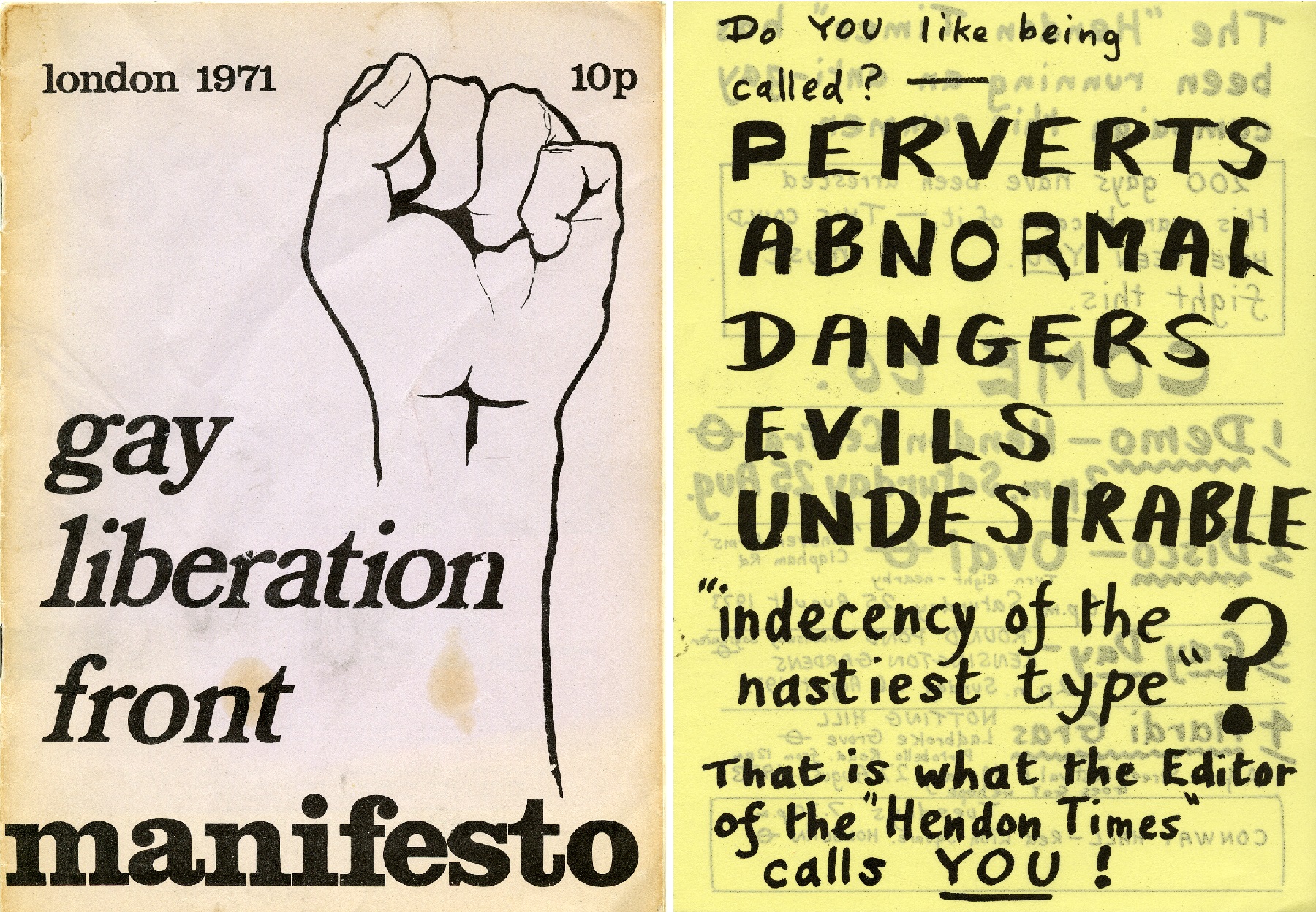
Gay Liberation Front pamplets and posters (Image: LGBTQ+ Archives, Bishopsgate Institute)
Nettie recalls a demonstration at the Champion pub, which wouldn’t serve people in drag or wearing GLF or women’s liberation badges. Her girlfriend Gaby Charing rang LBC from a phone box telling the radio station that there were hundreds of homosexuals in drag on their way to the pub. There were only about 10 of them, but Gaby believed that would get them there – and it did. “We decided to sit down on the floor and let the police drag us out. I remember Gaby, who was dressed in purple loons and a tank top, saying in a rather posh voice, ‘Tell me, officer am I in drag?’”
Sadly, Gaby passed away in late May this year, but her legacy endures through a passion for justice that continues to emanate from Nettie and her GLF peers.
Among its many other achievements, the GLF launched the Gay Switchboard, which over the years has provided much-needed information, advice and support for thousands of isolated, persecuted and fearful LGBTQ people, many of whom have had nowhere else to turn when faced with hostility from their families, work colleagues, or the general public. In 1974, GLF also helped launch Britain’s first ever paper, the fortnightly Gay News. The GLF also brought legal challenges against the unfair ‘age of consent laws’ (16 for heterosexuals, 21 for gay men). “Most importantly, it encouraged countless people to be proud, open and assertive about being lesbian or gay,” adds Ted.
As anybody who has ever been involved with a Pride committee will know, meetings aren’t without their tensions between the letters in the acronym LGBTQ. “There was a problem with some of the men who weren’t interested in women’s issues, as long as the age of consent was lowered and they could cottage,” says Nettie. “There were also men who saw the links between the oppression of women and their own oppression. It meant that people of opposite sexes could be close physically and emotionally without having to play sex roles with men having to be dominant and masculine and women subservient and feminine. Bringing men and women together for the first time was another wonderful thing about GLF.”
It is because of the diverging ambitions of the gay men’s and women’s rights movements that Nettie understands why the women’s group would eventually break away from the main GLF in January 1972. “The spirit had gone and it was never the same again for neither the men nor the women,” she says. “That is my opinion.”
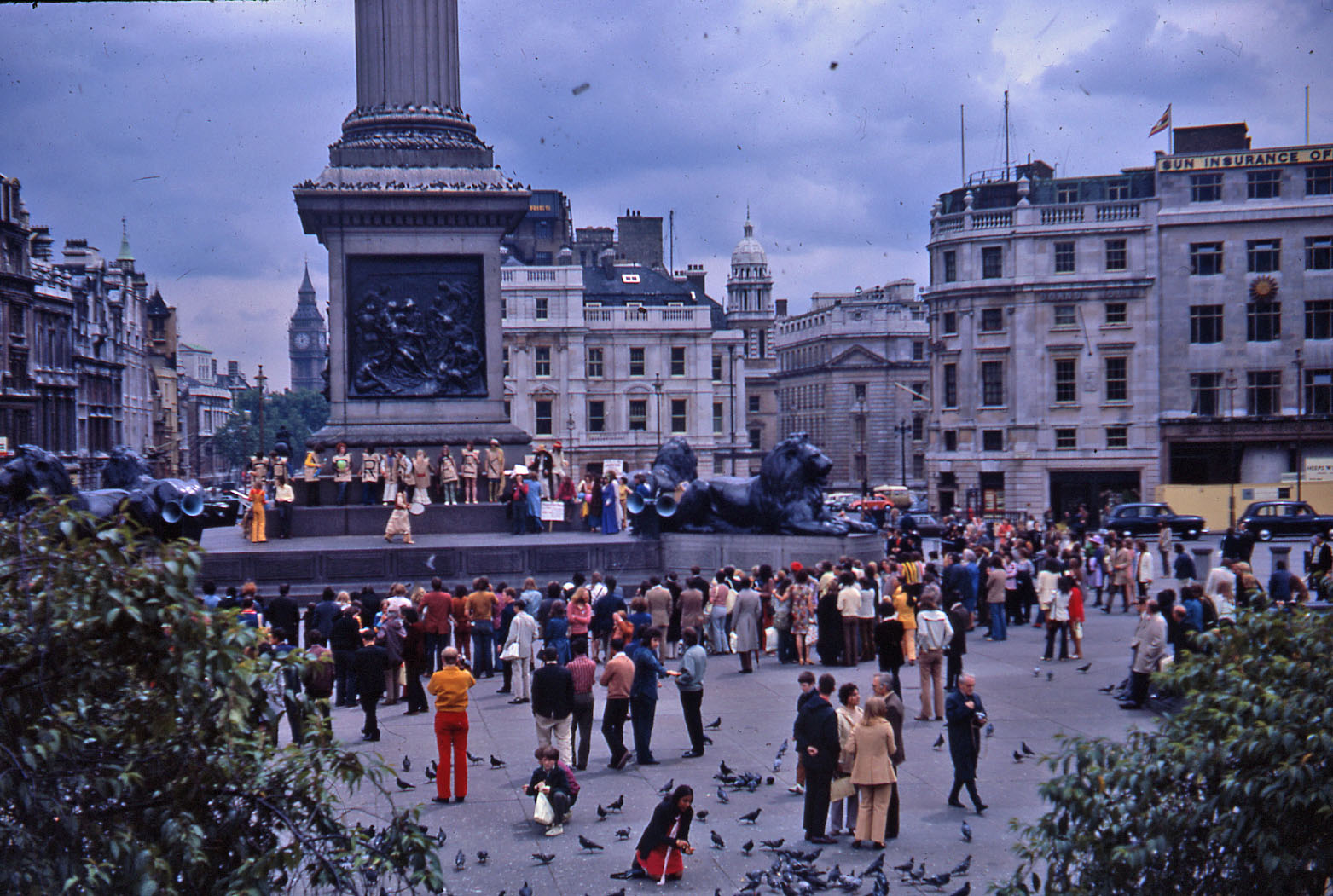
Gay Liberation Front protest in London’s Leicester Square, August 1972 (Image: LGBTQ+ Archives, Bishopsgate Institute)
As a young gay and black man, Ted also found his dual identities would sometimes sit uncomfortably against one another. “There was a considerable amount of patronising, rather than hate-filled racism,” he says of how some people would treat him and his fellow non-white queers. “Some people considered black people as novelties. Most white LGBT people shared the same ignorant ideas as the general population. Shows like All in The Family, The Black and White Minstrel Show, Love Thy Neighbour were still being broadcast on TV. There were a few people of colour like me involved at the start, who were determined to have a black presence in the campaigns, tackling homophobia and racism together.”
The photographs Ted took of the very first GLF march in British history in 1971 include black and Asian people, some of whom are still around. “It took about four or five years for me to be comfortable with my sexuality,” he says. “In my early 20s, I moved into one of GLF’s communes in Bounds Green – there were four or five that were located across London. There I became more than comfortable; in fact, celebratory. Not only was I living with other gay people, I moved in with Noel, the man who is still my love and now Civil Partner.”
It was a long journey to happiness for Ted, from acknowledging he was not like other boys at a young age to being a proud activist. “There were two major occasions of realising I was ‘different’. The first was related to my race, the second to my sexuality. Aged five, in America, my mother warned me to be cautious if ever alone near white people. Her warning came soon after the murders of several black children and youths by white racists; most notoriously, the horrendous lynching of 14-year-old Emmett Till.”
His next lesson in self-realisation came aged 11. “I was reassured by my mother that my attraction to another boy in school was a quite normal ‘passing phase’. But when at 15 I explained to her that I still found a couple of young men attractive, we both realised I was, in the language of the day, ‘becoming homosexual’.
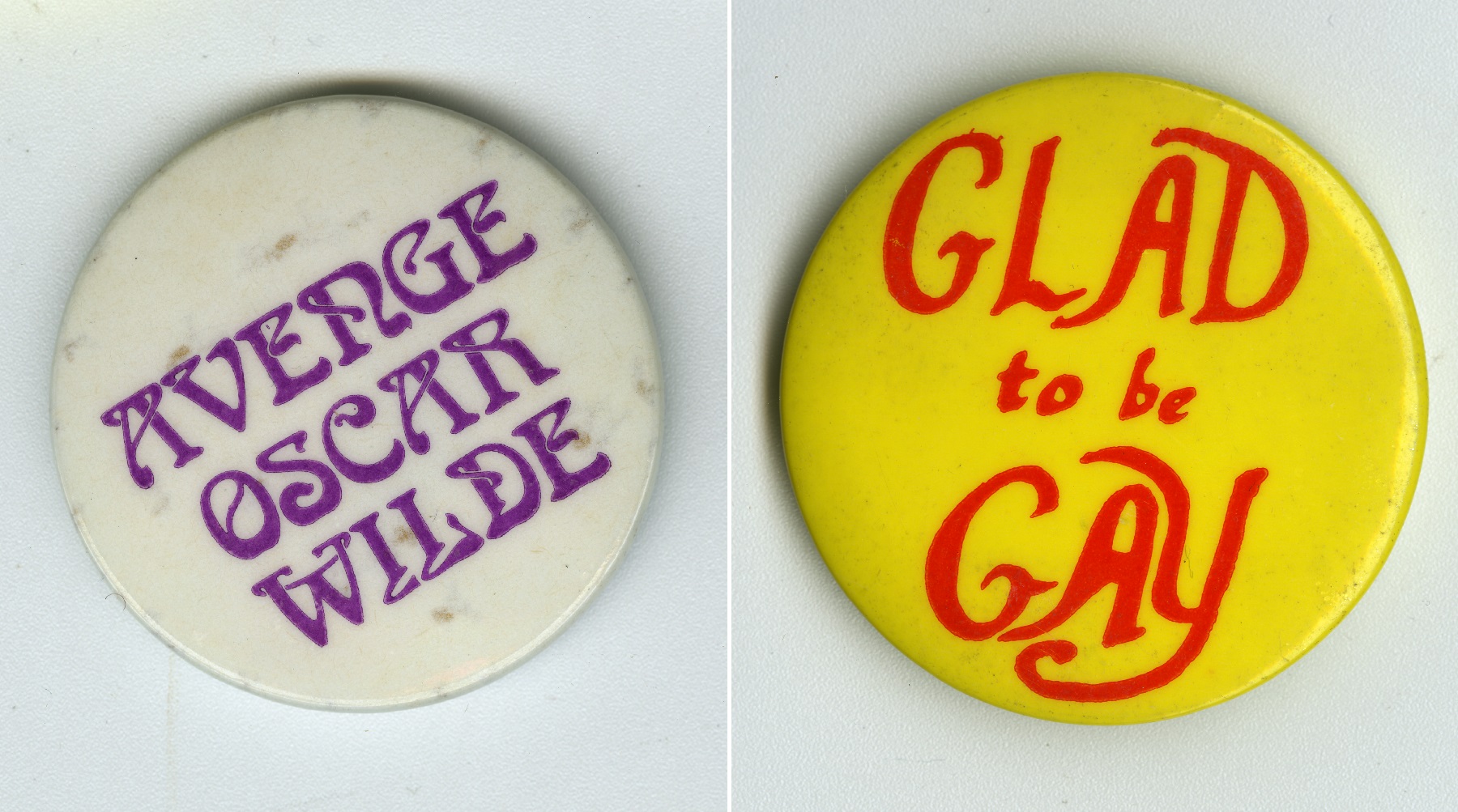
Some of the original badges worn by Gay Liberation Front members (Image: LGBTQ+ Archives, Bishopsgate Institute)
“Those childhood experiences of racism showed me how even supposedly educated, fair-minded organisations or people used it to inflict stereotypes, prejudice, and injustice against black people. That knowledge helped me realise that similar distortions were being used against homosexual people. Both forms of prejudice needed to be fought.”
Ted would go on to co-found Black Lesbians & Gays Against Media Homophobia (BLAGAMH), which successfully fought media attacks on black gay footballer Justin Fashanu and Buju Banton’s viciously homophobic song Boom Bye Bye.
Now in his seventies, Ted’s work continues. “My activism is about forming coalitions between those who are disadvantaged by negative social attitudes towards their gender, class, income, nationality, education, religion, sexuality, IQ, disability, or whatever to help us all fight for equality.”
Nettie too continues to work hard for a better future for all. Both Ted and her recently joined other early GLF members in Trafalgar Square to begin a year of celebration to mark five decades since the British contingent of the GLF formed.

For Nettie, her goal is as ambitious today as it was in the early days of GLF. “Absolute freedom for all! That’s what gives me hope! Today’s Pride in London wants us to try and join the establishment, buy a big house, and support our military. If you don’t comply with all that, you’re much more likely to be vulnerable, you’re much more likely to be exposed to homophobic abuse, you’re much more likely to suffer under multiple and overlapping vulnerabilities.
“The privileging of hetero-normative ideals, equal marriage, monogamy and keeping up with the neighbours… the GLF didn’t want to be part of it.”
Nettie highlights her fellow GLF members, most of whom were at those early meetings with her, as an ongoing inspiration. “I think what GLF means to all of us is absolutely life-changing. It changed us and it changed us for ever. Still today the bond we feel between each other is extraordinary. What we call rights — marriage, jobs, family, life — can easily be taken back by oppressive governments. Think Trump. Think Bolsonaro.
“I believe the only way forward is to join with others, not for a seat at the top table, but to abolish the top table. A change in the whole structure of society. At the moment, it means working with other marginalised groups such as trans, refugees, homeless, sex workers. We won’t make it unless we make it together.”
Further reading: No Bath But Plenty of Bubbles by Lisa Power and Blowing the Lid by Stuart Feather
